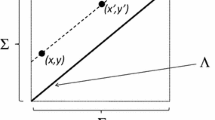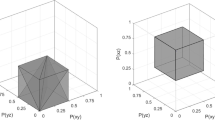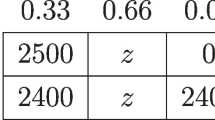Abstract
This paper provides an experimental test of stochastic choice models of decisions. Models that admit Fechnerian structure are tested through the repeated pairwise choice problems. Results refute the Fechner hypothesis that characterizing the probability of selecting a given prospect increases in how strongly it is preferred to alternative choices. However, the experimental data lend support to characterizing an individual’s binary choice probability as some scalable functions of the von Neumann–Morgenstern utilities in the risky context.




Similar content being viewed by others
Availability of data
The original experimental data are available upon request.
Notes
Here, for expository purposes, I assume that A is convex, where A is a mixture set in the official model setups.
See Remark 1 in Ryan (2018) for a detailed discussion on this matter.
I conducted a parametric random effects regression analysis to detect whether subjects behave differently in the later experimental repetitions, as opposed to the earlier repetitions, for the binary choice problems in MMT 4. No significant impact from either the ranking of the repetitions or the different subjects was found on the choice pattern for the \(\{D, V\}\) pairs.
References
Blavatskyy, P. R. (2008). Stochastic utility theorem. Journal of Mathematical Economics, 44, 1049–1056.
Carbone, E., & Hey, J. D. (1994). Estimation of expected utility and non-expected utility preference functionals using complete ranking data. In B. Munier & M. Machina (Eds.), Models and experiments on risk and rationality (Vol. 29, pp. 119–139). Kluwer Academic Publishers.
Debreu, G. (1958). Stochastic choice and cardinal utility. Econometrica, 26(3), 440–444.
Dekel, E. (1986). An axiomatic characterization of preferences under uncertainty: Weaking the Independence axiom. Journal of Economics Theory, 40(2), 304–318.
Edwards, W. (1961). Behavioral decision theory. Annual Review of Psychology, 12(1), 473–498.
Fishbacher, U. (2007). z-tree: Zurich toolbox for ready-made economic experiments. Experimental Economics, 10(2), 171–178.
Greiner, B. (2015). Subject pool recruitment procedures: Organizing experiments with ORSEE. Journal of the Economic Science Association, 1(1), 114–125.
Hey, J. D. (1995). Experimental investigations of errors in decision making under risk. European Economic Review, 39(3–4), 633–640.
Hey, J. D. (2001). Does repetition improve consistency? Experimental Economics, 4(1), 5–54.
Hey, J. D., & Carbone, E. (1995). Stochastic choice with deterministic preferences: An experimental investigation. Economics Letters, 47(2), 161–167.
Krantz, D. H. (1964). The scaling of small and large color differences. Ph. D. thesis, University of Pennsylvania.
Loomes, G., & Sugden, R. (1998). Testing different stochastic specifications of risky choice. Economica, 65(260), 581–598.
Machina, M. J. (1982). Expected utility analysis without the independence axiom. Econometrica, 50(2), 277–323.
Marschak, J. (1974). Binary-choice constraints and random utility indicators (1960). In Economic information, decision, and prediction: Selected essays: Volume I Part I economics of decision (Vol. 7, pp. 218–239). Springer.
Marschak, J. (1950). Rational behavior, uncertain prospects, and measurable utility. Econometrica, 18(2), 111–141.
Ryan, M. (2015). A strict stochastic utility theorem. Economics Bulletin, 35(4), 2664–2672.
Ryan, M. (2017). Random binary choices that satisfy stochastic betweenness. Journal of Mathematical Economics, 70, 176–184.
Ryan, M. (2018). Strict scalability of choice probabilities. Journal of Mathematical Psychology, 84, 89–99.
Ryan, M. (2021). Stochastic expected utility for binary choice: A ‘modular’ axiomatic foundation. Economic Theory, 72, 641–669.
Tversky, A., & Russo, J. E. (1969). Substitutability and similarity in binary choices. Journal of Mathematical Psychology, 6(1), 1–12.
Wilcox, N. T. (2008). Stochastic models for binary discrete choice under risk: A critical primer and econometric comparison. In Risk aversion in experiments (Vol. 12, pp. 197–292). Emerald Group Publishing Limited.
Acknowledgements
The author thanks Pavlo Blavatskyy, Denis Bouyssou, David Butler, Simona Fabrizi, John Hey, Steffen Lippert, Alan Rogers, Matthew Ryan, and Ronald Peeters for their valuable comments. The author also thanks the audiences at the 20th Annual Society for the Advancement of Economic Theory Meeting hosted by Seoul National University, at the International Summer School on ‘Preferences, Decisions and Games’ hosted by LIP6, Sorbonne University, at the 8th Microeconomic Theory Workshop hosted by Victoria University of Wellington; and at the 2018 Australia New Zealand Workshop in Experimental Economics, as well as the participants in research seminars at the University of Auckland and at Xi’an Jiaotong-Liverpool University for their helpful suggestions. The author also thanks the two anonymous referees and the editor for very useful comments on this paper.
Funding
This research was funded by the University of Auckland Faculty Research Development Fund #3717595.
Author information
Authors and Affiliations
Corresponding author
Ethics declarations
Conflict of interest
The author declares no conflict of interest. The funders had no role in the design of the study; in the collection, analysis, or interpretation of data; in the writing of the manuscript; or in the decision to publish the results.
Ethics approval
The ethical approval to conduct this research with human subjects was obtained from the University of Auckland Human Participants Ethics Committee on October 5, 2018 (with reference number 022169).
Additional information
Publisher's Note
Springer Nature remains neutral with regard to jurisdictional claims in published maps and institutional affiliations.
Appendix
Appendix
This appendix Table 6 provides a summary of the 60 pairwise choice problems used in the experiment.
Rights and permissions
About this article
Cite this article
Pan, A. Empirical tests of stochastic binary choice models. Theory Decis 93, 259–280 (2022). https://doi.org/10.1007/s11238-021-09843-y
Accepted:
Published:
Issue Date:
DOI: https://doi.org/10.1007/s11238-021-09843-y




